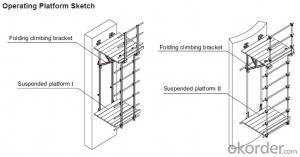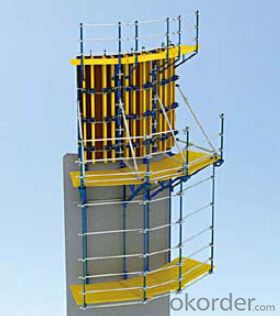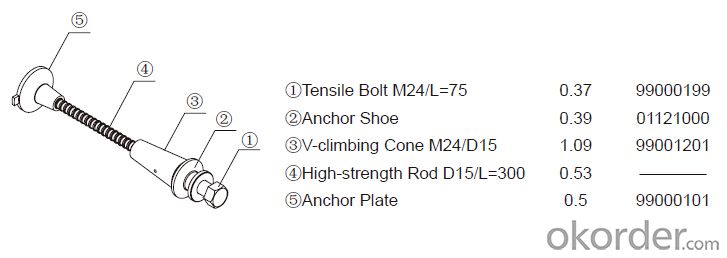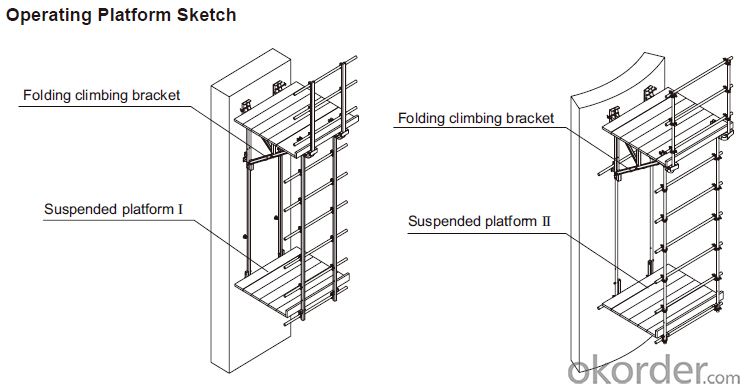Climbing platform CP190 for formwork and scaffolding system
- Loading Port:
- Tianjin
- Payment Terms:
- TT OR LC
- Min Order Qty:
- 50 m²
- Supply Capability:
- 1000 m²/month
OKorder Service Pledge
OKorder Financial Service
You Might Also Like
Climbing Platform CP190
Climbing bracket CP190 is mainly used as operating platform during construction. It can be used
on the vertical wall and arced wall. The bracket hang on the anchor system and all the load are
supported by anchor system. It’s convenient to assemble and dismantle, the construction is easy,
rapid and safe.
Anchor System:
Anchor system is the most important supporting part. The system is made of five parts shown
below. There into, tensile bolt, anchor shoe and V-climbing cone can be taken out for reusing.
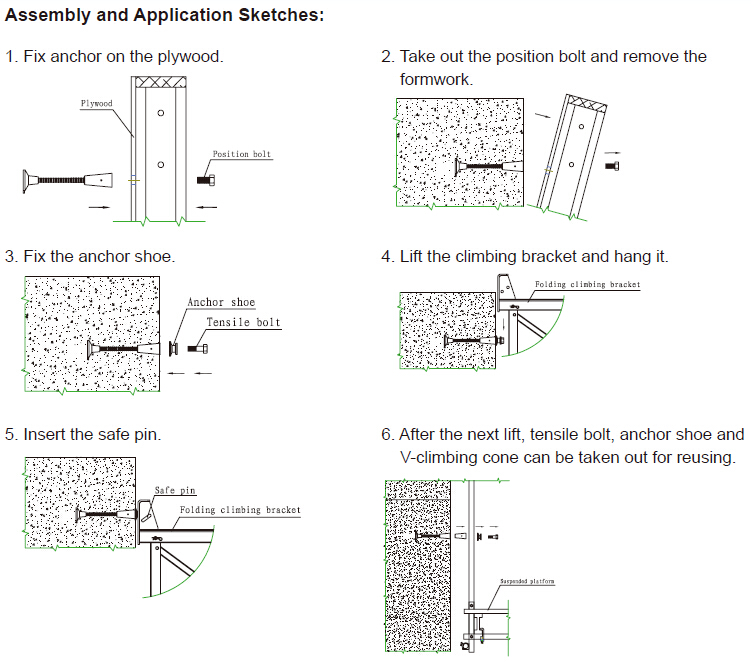
- Q: Can steel formwork be used for both residential and commercial renovations?
- Indeed, both residential and commercial renovations can make use of steel formwork. Renowned for its durability and strength, steel formwork proves itself suitable for diverse construction endeavors. Whether it involves a residential renovation, such as extending a property, or a commercial renovation, like refurbishing an office space, steel formwork delivers the required support and stability throughout the construction phase. Moreover, steel formwork readily lends itself to customization and adjustment to meet various project specifications, rendering it a versatile choice for both residential and commercial renovations.
- Q: Can steel formwork be recycled?
- Yes, steel formwork can be recycled. Steel is a highly recyclable material, and it can be melted down and reused to create new steel products. This makes steel formwork a sustainable and environmentally friendly choice in construction projects.
- Q: How does steel formwork prevent concrete leakage?
- Steel formwork prevents concrete leakage by providing a strong and rigid structure that holds the concrete in place during the pouring and curing process. The steel panels are tightly connected and sealed to prevent any gaps or openings through which the concrete could escape. The formwork panels are designed and assembled in a way that ensures a watertight construction. The joints between the panels are securely fastened and sealed with rubber gaskets or other waterproofing materials. This prevents any seepage or leakage of the concrete mixture. Additionally, steel formwork is typically reinforced with braces and other support systems to maintain its structural integrity and prevent any movement or shifting during the pouring process. This stability ensures that the concrete remains contained within the formwork and doesn't escape through any weak points. Furthermore, the smooth surface of steel formwork prevents the concrete from adhering to it. This allows for easy removal of the formwork after the concrete has cured, without any concrete residue remaining or damaging the structure. Overall, steel formwork provides a reliable and durable solution for preventing concrete leakage. Its strong construction, tight joints, and smooth surface ensure that the concrete remains contained within the formwork, resulting in a high-quality and leak-free concrete structure.
- Q: How does steel formwork contribute to the overall strength and stability of a structure?
- The construction industry heavily relies on steel formwork to enhance the strength and stability of structures. This crucial component plays a vital role in maintaining the integrity and durability of buildings by providing a dependable support system during the process of pouring concrete. To begin with, steel formwork possesses exceptional strength and rigidity, enabling it to withstand the immense weight and pressure exerted by wet concrete. Its sturdy construction ensures that it does not deform or collapse under these heavy loads, thereby preventing any potential damage or compromise to the stability of the structure. Furthermore, steel formwork provides an accurate and precise framework for pouring concrete. The dimensional stability of steel ensures that the formwork retains its shape and dimensions throughout the construction process. This accuracy is crucial in achieving a structurally sound and level structure, as any misalignment or irregularity in the formwork can lead to uneven distribution of concrete and weaken the overall strength of the building. Moreover, steel formwork exhibits excellent resistance to moisture and corrosion. This resistance guarantees that the formwork remains intact and structurally sound, even in environments with high humidity or exposure to water. By preventing rust and deterioration, steel formwork maintains its strength and stability over time, thus contributing to the long-term durability of the structure. Another notable advantage of steel formwork is its reusability. Unlike traditional wooden formwork, steel formwork can be reused multiple times without compromising its structural integrity. This reusability not only reduces construction costs but also minimizes waste and environmental impact. The ability to reuse steel formwork ensures that subsequent concrete structures maintain consistent strength and stability, without any compromise in quality. In conclusion, steel formwork is an indispensable element in the construction industry, significantly enhancing the strength and stability of structures. Its exceptional strength, dimensional accuracy, resistance to moisture and corrosion, and reusability make it an ideal choice for ensuring the integrity and durability of concrete structures. By providing a robust and reliable support system, steel formwork plays a pivotal role in the construction of safe and long-lasting buildings.
- Q: What are the common design considerations for steel formwork in cold climates?
- In cold climates, there are several common design considerations for steel formwork that need to be taken into account. These considerations are crucial to ensure the structural integrity, safety, and efficiency of the formwork system in such extreme weather conditions. 1. Material Selection: Choosing the appropriate steel grade is essential to ensure the formwork's ability to withstand low temperatures without compromising its strength. High-quality steel with good cold resistance properties should be selected to prevent brittleness and potential failure. 2. Insulation: Incorporating insulation materials into the design can help minimize heat loss during concrete curing. Insulating the formwork walls and base can prevent freezing, which may lead to cracking and reduced structural integrity. 3. Thermal Expansion: Cold temperatures can cause steel to contract, which may result in misalignment and buckling of the formwork. To accommodate thermal expansion and contraction, expansion joints or flexible connections should be included in the formwork design. 4. Anchoring and Support: Cold climates often experience freeze-thaw cycles, which can generate significant ground movement. Proper anchoring and support systems must be incorporated into the formwork design to ensure stability and prevent shifting or settling. 5. Durability and Corrosion Resistance: Cold and humid environments can accelerate corrosion of steel. Incorporating corrosion-resistant coatings or galvanizing the steel formwork can enhance its durability and prolong its lifespan. 6. Load Capacity: Cold climates are frequently associated with heavy snowfall. The formwork design should consider the additional loads imposed by accumulated snow on the structure to prevent overloading and potential collapse. 7. Fastening Systems: Cold temperatures can affect the performance of fastening systems, such as bolts and screws. Using appropriate fasteners that can withstand low temperatures and prevent loosening due to thermal contraction is crucial. 8. Ease of Assembly and Dismantling: In cold climates, it is important to consider the ease of assembly and dismantling of the formwork, as extreme temperatures may hinder construction activities. Designing the formwork system with easy-to-use connections and fasteners can improve efficiency and reduce construction time. By considering these common design considerations, engineers and designers can ensure that steel formwork in cold climates is safe, reliable, and capable of withstanding the harsh conditions.
- Q: What are the common cost-saving strategies when using steel formwork?
- Some common cost-saving strategies when using steel formwork include reusing the formwork for multiple projects, accurately measuring and cutting the formwork materials to minimize waste, properly maintaining and storing the formwork to prolong its lifespan, and utilizing innovative formwork systems that allow for faster installation and dismantling.
- Q: Is steel formwork suitable for all types of construction projects?
- No, steel formwork may not be suitable for all types of construction projects. It is commonly used in large-scale projects that require repetitive use of formwork, such as high-rise buildings or bridges. However, for smaller or more intricate projects, other types of formwork materials like wood or plastic may be more appropriate. The choice of formwork depends on factors such as project size, complexity, budget, and specific requirements.
- Q: How does steel formwork affect the overall thermal performance of the building?
- Steel formwork does not directly affect the overall thermal performance of the building as it is primarily used in the construction process for shaping and supporting concrete structures. However, if steel formwork is not properly insulated or if there are gaps between the formwork and the concrete, it can contribute to thermal bridging, which can negatively impact the building's energy efficiency.
- Q: Can steel formwork be used for structures with high fire resistance requirements?
- Steel formwork can indeed be used for structures with high fire resistance requirements. Steel is known for its excellent fire resistance properties as it has a high melting point, which means it can withstand high temperatures for a longer period of time compared to other materials. This makes it an ideal choice for structures that need to meet stringent fire safety standards. When using steel formwork, it is important to ensure that the design and construction techniques are in line with the fire resistance requirements. The steel formwork should be properly insulated to prevent the transfer of heat to the concrete structure during a fire. This can be achieved by using fire-resistant insulation materials or by applying a fire-resistant coating to the steel formwork. Additionally, it is crucial to consider the fire resistance of the concrete itself. Concrete is inherently fire-resistant due to its low thermal conductivity and high density. However, the inclusion of certain additives, such as fire-resistant admixtures or fibers, can further enhance the fire resistance of the concrete. By combining the fire-resistant properties of steel formwork with appropriate design and construction techniques, it is possible to achieve structures that meet high fire resistance requirements. However, it is always recommended to consult with fire safety experts and adhere to local building codes and regulations to ensure the highest level of fire safety in any construction project.
- Q: Can steel formwork be used for both above-ground and below-ground structures?
- Yes, steel formwork can be used for both above-ground and below-ground structures.
Send your message to us
Climbing platform CP190 for formwork and scaffolding system
- Loading Port:
- Tianjin
- Payment Terms:
- TT OR LC
- Min Order Qty:
- 50 m²
- Supply Capability:
- 1000 m²/month
OKorder Service Pledge
OKorder Financial Service
Similar products
Hot products
Hot Searches
Related keywords


